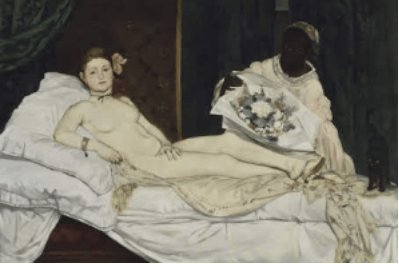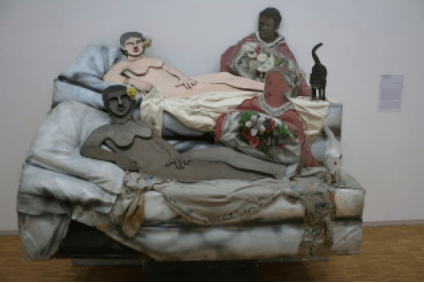Hannah Kim, On Édouard Manet and Larry Rivers
Perspectives are different for every person. What you think when seeing an artwork may not apply to another person. I believe Olympia by Édouard Manet is an excellent example of this case.
Born in 1832 in Paris, Manet bridged the gap between Realism and Impressionism, the two most important art movements of the 19th century.1 There are numerous artworks that Manet created, but I will be explaining one of the most controversial artworks he has ever made: Olympia. Olympia was a painting from 1863, accepted by the Salon of 1865, the official art exhibition of the Académie des Beaux-Arts in Paris. The acceptance of Olympia evoked significant criticism from society at that time. You may wonder why. Take a look at the painting:

As you can see, the main subject of this painting is a nude woman lying on a bed. Nude paintings themselves were uncommon during the period, and many people thought it was very flagrant. Yes, nude paintings were existent, but many artists would indirectly show them by covering them with a thin cloth. Unlike the ordinary, Manet took a new approach and directly delivered the uncovered body. However, this was not the central conflict this painting provoked: the small details on the woman indicated that she was a sex worker.2 For instance, the accessories and flowers denote that they are gifts from her client. Some viewers took his artwork very offensively, beginning to question his motives for his artwork.
For these reasons, crowds were indeed upset when the Salon accepted his artwork. It even led to research on why the jury has allowed Olympia to be showcased despite its untraditional style.
Additionally, Olympia also aroused racial problems with the African American woman signifying a servant. This artwork has helped many scholars understand the racism occurring during that period because it directly shows the clear distinction between the two women.
With such controversies surrounding the artwork, many artists recreated Olympia with their perceptions. One example would be Larry Rivers. Born in 1923, Larry Rivers enjoyed creating artwork in the style of Abstract Expressionism and Pop art. Just as a fun side note, Larry Rivers received his Bachelor of Arts in art education from New York University. Going back on topic, not long after the Civil War, in 1970, Larry Rivers made a parody of Olympia called I Like Olympia in Blackface. With the combination of sculpture and painting, his work reverses the roles of Édouard Manet’s Olympia and her African servant.3 Here is how the piece looks like:

I believe Larry River’s work does a great job showing the difference between the two different periods, as the focus of this artwork shifts from something sexual to racial. Small details like the black and white cats also add a lot to the distinction between the two pieces. Overall, River’s work shows how society’s standards have changed over time.
When I first saw Olympia through a recommendation from my teacher, I was honestly not much wowed by the piece. It seemed pretty similar to artworks that I have seen in the past with nude women as subjects, showing their beauty. However, after paying attention to the minor details and hearing the story behind the work, I was certainly surprised. I have never approached an artwork that received so much criticism for such a long period. My teacher asked me to observe the painting fully before searching up Larry Rivers’s piece. After seeing his work, I certainly had a new way of seeing the original Olympia. It is fascinating how one artwork can be seen in such a different viewpoint after seeing recreations of that artwork. After viewing both pieces, I talked about them with my peers and was amazed by how everyone had contrasting parts that caught their attention. It once again made me realize how art can never be defined in one way because everyone thinks differently.
Although controversial, I think Olympia by Édouard Manet completely changed the face of art in France. His work not only inspired other artists to go out of the box and challenge themselves but also evoked people to discuss significant conflicts that many people may have avoided. Other than I Like Olympia in Blackface, there are many other recreations of Manet’s Olympia, so I recommend everyone to take a look at other artworks too.
1 Tessa Solomon, ARTnews: Édouard Manet Is Considered the Father of Modernism. Here Are His Most Famous Works. (30 April. 2020,)
https://www.artnews.com/art-news/artists/why-is-edouard-manet-important-1202685425/
2 PBS Culture Shock: The Shock of The Nude: Manet’s Olympia,
https://www.pbs.org/wgbh/cultureshock/beyond/manet.html
3 Guggenheim: Larry Rivers: https://www.guggenheim.org/artwork/artist/larry-rivers